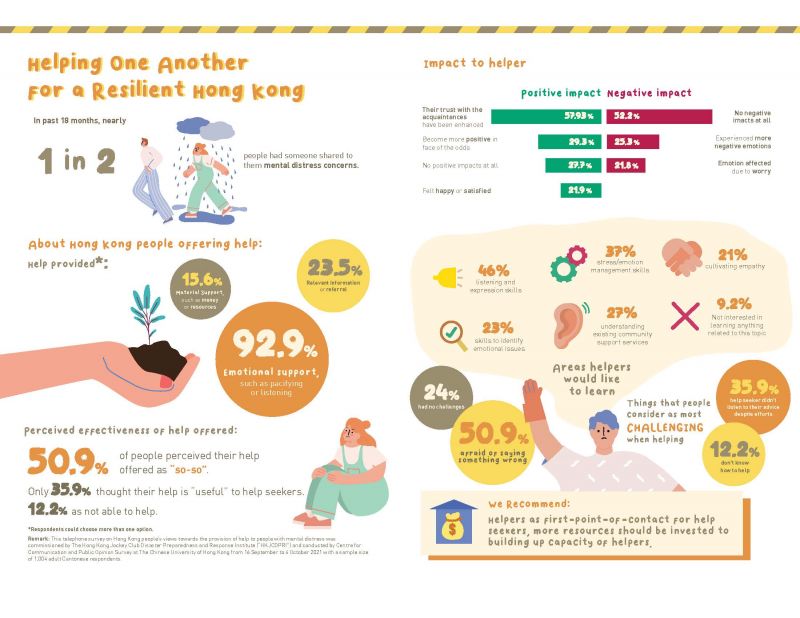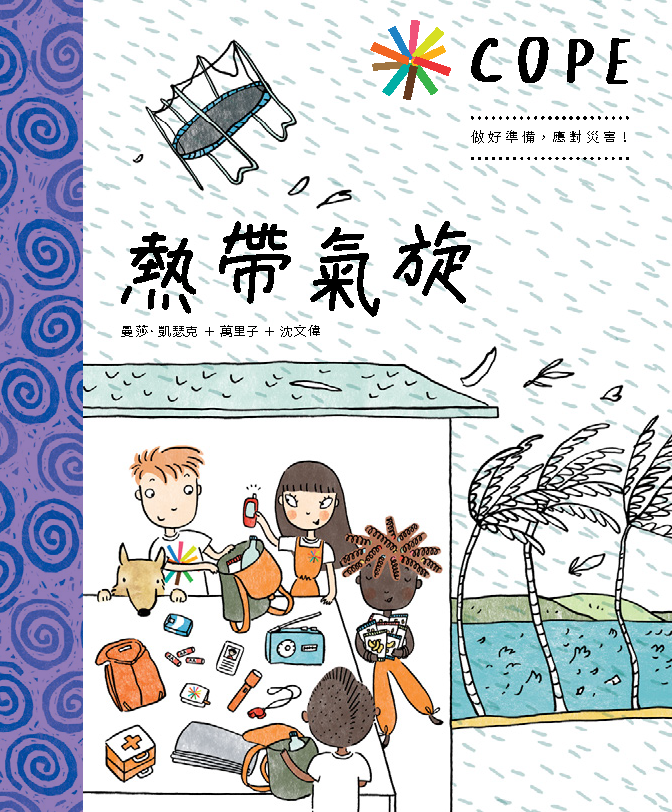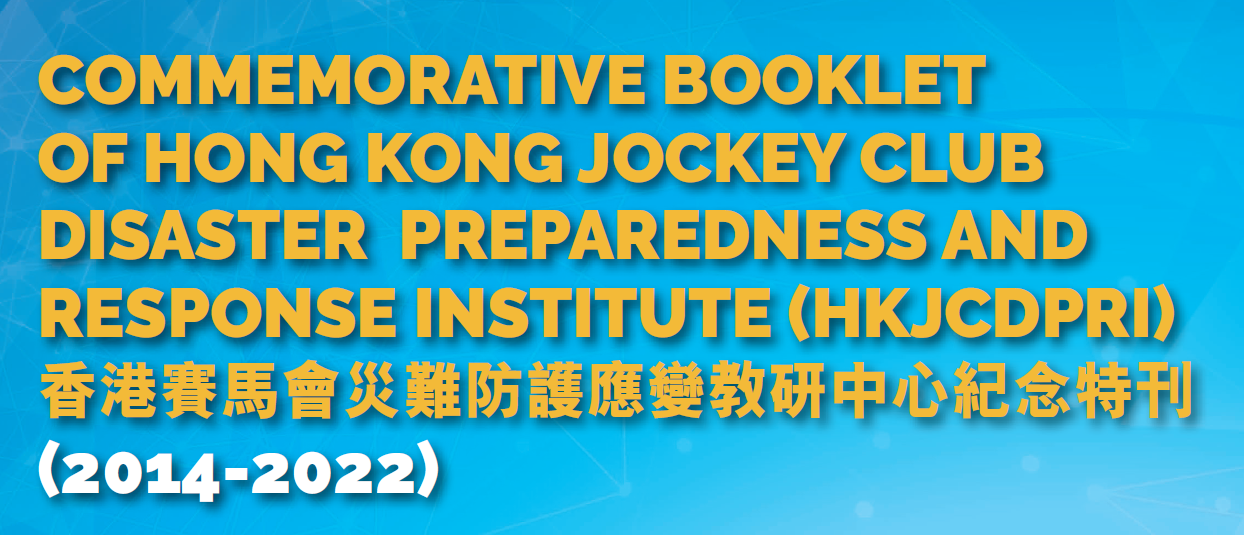You are here
Publications & Research
Publications & Research

Publications & Research
The HKJCDPRI Publications Section contains collaborative researches and publications with our partners and renowned academic institutions, and other research and development projects related to disaster preparedness and response.
The Guidelines section contains our selected collection of technical information, operational guidelines and useful tools for disaster management.
The Blog sub-section provides a platform where our team and peers share news and updates, as well as opinions and experiences in building disaster preparedness for the communities.
The blog posts are written by the author in his own personal capacity / affiliation stated. The views, thoughts and opinions expressed in the post belong solely to the author and does not necessarily represent those of Hong Kong Jockey Club Disaster Preparedness and Response Institute.
All resources listed here are freely and publicly available, unless specified otherwise. We ask users to use them with respect and credit the authors as appropriate.
2022

The Hong Kong Jockey Club Disaster Preparedness and Response Institute (“HKJCDPRI”) has commissioned the Centre for Communication and Public Opinion Survey (“CCPOS”) at The Chinese University of Hong Kong (“CUHK”) to conduct an opinion survey about Hong Kong people’s views towards the provision of help to people with mental distress (“the Survey”). Specfically, the Survey aimed to examine the following issues:
- Opinions on providing help to people with mental distress
- Mental distress situation of acquaintance
- Situations of providing help to acquaintance with mental distress
- Opinions on learning how to acquaintance with mental distress

A telephone survey was conducted from 16 September to 4 October 2021 with Hong Kong residents aged 18 or above (Cantonese speakers), which produced a sample size of 1,004 respondents. The main findings of the Survey are summarized as follows:
Opinions on providing help to people with mental distress
- The respondents were asked whether they would be willing to provide help when other people mentioned their mental distress (such as unhappiness, worry, anexiety or anger, etc.) to them. Over seven in ten repsondents (71.9%)said they were willing to help; more than one-fifth (22.5%) said “so-so”; and only a tiny portion (3.2%) said not willing.
- If there were a need for the respondents to help the people with mental distress, over half of them (56.7%) said their confidence level of provding useful help to the people in need was just “so-so”. The proportion of respondents lacking confidence (23.5%) was higher than that of respondents having the confidence (18.3%).
- The respondents thought that the main difficulties of helping the people with mental distress were “don’t know how to help them” (44.3%), “don’t know how to pacify them” (32.0%), “no time” (20.1%) and “don’t understand their troubles” (19.9%)。
Mental distress situation of acquaintance
- Nearly half of the respondents (47.9%) have had their acquaintances (including family members, friends, colleagues, classmates, neighbours or people they met in work) mentioning to them about their mental distress (such as unhappiness, worry, anexiety or anger, etc.) in the past 18 months. And over half of the respondents (52.1%) said they have not encountered this situation.
- Those acquaintances were mainly the “friends” (65.3%), “family members” (31.2%) and “colleages” (20.4%) of the respondents.
- The main sources of mental distress of those acquaintances were about “family” (37.0%) and “work” (36.7%) and as well as “social events” (30.0%) and “the pandemic” (29.2%).
- According to the respondents, those acquaintances mainly had the following symptoms of mental distress: “easy to feel depressed, worried or panicky” (47.9%), “easy to feel anxious, angry or frustrated” (43.6%) and “always suffer from insomnia ” (43.3%).
- Over half of the respondents (51.5%) said that, there was no difference in the number of people mentioning to them about their mental distress between now and before the pandemic. However, more than two-fifths of the respondents (45.7%) said the number of help-seekers has increased; whereas a tiny portion of the respondents (2.4%) said there were fewer help-seekers now.
Situations of providing help to acquaintance with mental distress
- For those respondents who have had their acquaintances mentioning to them about their mental distress in the past 18 months, the overwhelming majority of them (98.1%) have tried/ sometimes have tried to provide some forms of help to the help-seekers, such as listening to their concerns or providing them information or advices. Only a tiny portion of the respondents (1.9%) have not tried to provide any help at all.
- The help being provided by the respondents was mainly “emotional support, such as pacifying or listening”(92.9%). It was then followed by “provding information or referral” (23.5%) and “material support, such as money or resources, etc.” (15.6%).
- In the helping process, the main difficulties encountered by the respondents were “afraid of saying wrong things” (34.4%), “the help-seekers were not listening even I have already spoken a lot” (34.2%) and “don’t know how to help” (31.0%).
- The respondents were asked to evaluate whether their provided help could be able to help the help-seekers. Around half of the respondents (50.9%) said the outcome was only “so-so”. Over three in ten respondents (35.9%) believed that their help was useful for the help-seekers; however, over one in ten respondents (12.2%) believed that their provided help was not able to help the help-seekers.
- Nearly three-fifths of the respondents expressed that having provided help to the acquaintances with mental distress, “their trust with the acquaintances have been enhanced” (57.3%). Nearly three in ten respondents said that they “have become more positive in face of the odds” (29.3%). Moreover, about one-fifth of the respondents “have felt happy or satisfied” (21.9%). However, there was also more than a quarter of the respondents (27.7%) experiencing “no positive impacts at all” in helping others.
- As far as negative impacts are concerned, over half of the respondents (52.2%) said that providing help to the acquaintances with mental distress has caused “no negative impacts” on them. However, over one-fifth of the respondents have said “they have experienced more negative emotions” (25.3%) and “their emotion has been affected because of worry” (21.8%) respectively.
- As mentioned above (point 9), some respondents have not tried/ sometimes have not tried to provide help to the acquaintances with mental distress. Their main reasons were “don’t know how to help” (47.9%), “the relationship with them wasn’t that close” (18.3%), “they may not want me to help them” (11.9%), “just trivial matters; no need to help” (10.7%) and “afraid of being troubled” (7.9%).
Opinions on learning how to acquaintance with mental distress
- Finally, the Survey asked all respondents what knowledge or skills they would like to learn for helping people with mental distress. The top choice was “listening and presentation skills” (46.2%), which was followed by “the methods of reducing stress or releasing emotions (36.6%), understanding“existing supportive services in the community” (26.8 %), “identifying emotional health problems” (22.7%) and “cultivating empathy” (20.6%). However, close to one in ten repsondents (9.2%) have expressed no interest in all above-mentioned items.
2020

In times of Sudden Onset Disaster (SOD), timely emergency medical services are crucial to the affected communities. Being seen as one of the most important approach in emergency situations, emergency medical teams have a long history of responding to SODs such as the Haiti earthquake, the Indian Ocean Tsunami and the floods in Pakistan.
The World Health Organization has launched the Emergency Medical Teams (EMTs) initiative, formerly known as Foreign Medical Teams (FMTs) initiative, to introduce a classification, minimums standards and a registration system for EMTs that may provide quality healthcare services arriving within the aftermath of a SOD. The initiative historically focused on trauma and surgical needs, but outbreaks in Africa (Ebola) and Asia (diphtheria) have shown that EMTs’ responses are also valuable in responses to outbreaks and other forms of emergency which exceed the capacity of the local health system. [1]
SODs like earthquakes could cause mass casualty, and the surge in the needs for healthcare services could evolve within days, if not hours. In the article titled “Decision Support Framework for Deployment of Emergency Medical Teams after Earthquakes”, Bartolucci et. al. has summarized the evolvement of health needs in earthquake situation and observed that emergency surgical conditions reduced by 50% within the first week after the onset of the earthquake. The number of trauma cases dropped to less than 10% after 15 days.
According to another report published by WHO and the International Federation of Red Cross and Red Crescent Societies (IFRC) in 2017, The Regulations and Management of International Emergency Medical Teams [2], the timing of deployment (the time that the EMT is ready to attend to its first patient) in most of the SODs was not recorded properly. The study summarized some available data of several recent emergency operations, and has shown that the timing of deployment could vary from 2 days to 18 days. Yet in an emergency, the healthcare needs on ground may have changed drastically after 18 days.
Bartolucci et. al. continued to summarize experts’ opinions with a Delphi study followed by literature search and created an evidence-based framework for EMT coordinators and decision makers. The framework targets to facilitate decisions making in the configuration and capacity of the EMT. It can also facilitate a better estimation on the potential needs on ground so that EMTs can provide a timelier and quality healthcare service to the affected communities.
The article and the decision-making framework are available in the link below:
Decision Support Framework for Deployment of Emergency Medical Teams after Earthquakes
Reference:
[1] Fact Sheet: Emergency Medical Teams (EMTs), World Health Organization, May 2019
[2] The Regulations and Management of International Emergency Medical Teams, World Health Organization (WHO) & International Federatio of Red Cross and Red Crescent Societies (IFRC), June 2017
Elaine FONG
Manager (Professional and Knowledge Management)
Hong Kong Jockey Club Disaster Preparedness and Response Institute
*This article originates from a research funded by the Hong Kong Jockey Club Charities Trust within the collaborative project “Training and Research Development for Emergency Medical Teams with reference to the WHO Global EMTs initiative, classification and standards” between the Humanitarian and Conflict Response Institute (HCRI) and the Hong Kong Jockey Club Disaster Preparedness and Response Institute (HKJCDPRI)”.
2019

Natural hazards have direct and indirect health impacts. Apart from physical and mental trauma, other health impacts include malnutrition, disrupted disease treatment plans, and risk of infectious diseases. Health impacts may be mitigated through health-related emergency and disaster risk management (Health-EDRM). They are systematic analysis and management of health risks through the reduction of hazards and vulnerability in all stages of the disaster management cycle, from prevention/mitigation, preparedness, response to recovery (Lo et al., 2017; World Health Organization [WHO], 2019).

A global disaster book series is now available free-of-charge in Hong Kong for our kids!
The COPE Squad from the picture book series, COPE, is here to teach all Hong Kong kids how to Get Ready and Be Prepared in face of disasters! Under the guidance of Grand Mistress Fu, the four main characters of the series, namely Candy, Ollie, Ping and Eddy form the COPE Squad and undergo intensive training on natural disasters and how to be prepared. COPE's mission is to educate children from all over the world, so they can become COPE Champions to act as disaster role models in their community.

COPE is a series of fun, innovative and beautifully illustrated children’s books intended for global distribution to increase the disaster resilience of children. According to the Sendai Framework for Disaster Risk Reduction (2015-2030), which was adopted at the third United Nations (UN) World Conference on Disaster Risk Reduction in March 2015, children have a vital role to play in reducing risk, strengthening community resilience and shaping legislation to better protect against disasters. COPE’s touching and humorous illustrations will capture children’s imagination to teach them simple steps for disaster preparedness, which may one day save their lives.
The book targets at young readers aged 9-11 and parents reading to their children, aged 4-8. While the COPE books are written primarily in English with collaborative efforts from various contributors, the Hong Kong Jockey Club Disaster Preparedness and Response Institute (HKJCDPRI), together with the Hong Kong Observatory, Dr Loretta Tam and Dr Kwan Che Ying, Associate Professor, Centre for Advancement of Chinese Language Education and Research, The University of Hong Kong, have localised the contents of the book for Hong Kong readers. Today, five books, the Earthquake! (“地震!”) ,Get Up To High Ground (“走上高地”) (for Tsunami), COVID-19 (“新冠病毒病”), Flood (“水災”) and Cyclone (熱帶氣旋), have been localised and translated in Chinese.
Click and join the COPE Squad’s cyclone mission to Queensland, Australia.

Let’s embark on journeys of discovery into the world of disasters with COPE. Make a difference today! Get Prepared and Be Ready!
Please click the graphic below to download the PDF file of the book:
Click and join the COPE Squad’s Floods mission to Kelantan State, Malaysia

Click and join the COPE Squad’s COVID-19
Click and join the COPE Squad’s earthquake mission to Colima, Mexico
Click and join the COPE Squad’s tsunami mission to Matsushima, Japan.
Click and join the COPE Squad’s cyclone mission to Queensland, Australia.
Click and join the COPE Storm Surges
The global COPE Disaster Book Series Website:
https://cope-disaster-champions.com/disaster-book-series/
The Global Author, Illustrator and Editor Team of the COPE:
- Martha Keswick is the author of the popular bilingual Max and Mei picture book series, the factual Zhongguo Mingren Series about famous people of China and the action-packed Pangu comic book series. Martha’s work for the Keswick Foundation often supports disaster related projects in China.
- Mariko Jesse, the illustrator, studied at Central St Martins, where she was also an Associate Lecturer. She is a highly acclaimed freelance commercial illustrator, children’s book illustrator and printmaker specializing in Japanese woodblock printing.
- Dr Timothy Sim, the editor, started out as a social worker, specializing in family therapy and started focusing on disaster risk reduction, writing many books in Chinese and English since working with children, their families, schools, and communities affected by the horrific Wenchuan earthquake in 2008. Tim is currently a professor at the Singapore University of Social Sciences.

The Contents Localisation and Adaptation Team for Hong Kong Editions:
- Hong Kong Jockey Club Disaster Preparedness and Response Institute (HKJCDPRI)
- Hong Kong Observatory
- Dr Loretta Tam
- Dr Kwan Che-ying, Associate Professor, Centre for Advancement of Chinese Language Education and Research, The University of Hong Kong
Acknowledgement of Support:
WHO Collaborating Center for Community Health Services, School of Nursing, The Hong Kong Polytechnic University













